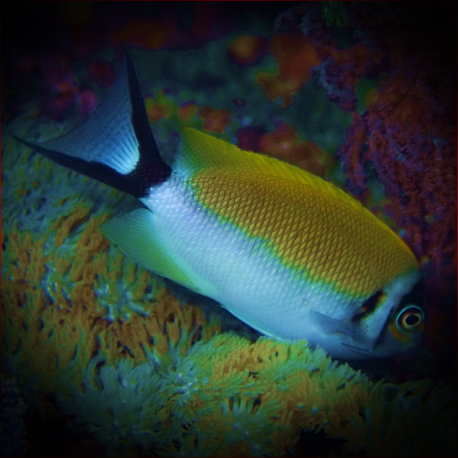More info
Datasheet
| Minimum Tank Size | 700 litres / 184.92 US gallons |
| Maximum Size | 21.0cm / 8.27inches |
| Reef Compatible | Reef safe with caution |
| Temperament | Might be aggressive towards similar species |
| Temperature | 22.2°C / 71.96°F - 25.6°C / 78.08°F |
| Specific Gravity | 1.020-1.025 |
| Carbonate Hardness | 8-12 |
| pH | 8.1-8.4 |
General Description
The Genicanthus semifasciatus, also known as the Japanese Swallow, belongs to the Pomacanthidae family and is recognized by its lyre-like tail. These colorful and impressive angelfish are distinguishable by their feeding habits, as they hunt zooplankton in the open ocean while also consuming microalgae, fish eggs, and small invertebrates. They are well-suited for coral aquariums due to their minimal coral-feeding tendencies, making them an attractive addition to marine habitats.
Aquarium Suitability
Suitable with care, these angelfish require dim lighting initially for acclimatization and prefer a diet rich in zooplankton, microalgae, fish eggs, and small crustaceans. They thrive in a well-established aquarium with algae for grazing, needing hiding spots amongst live rocks for security.
Demands
The Japanese Swallow necessitates frequent feeding multiple times a day, especially upon introduction to an aquarium, with a diet that includes larger crustaceans, microalgae like spirulina, and small crustaceans such as krill and mysis. They thrive best in a spacious aquarium and are known for their compatibility in pairs or with one male and multiple females.
Care and Hardiness
With an average level of hardiness, these angelfish may find acclimatization challenging, particularly for certain individuals. They are known to need ample swimming space, hiding places, and a varied diet for optimal health and well-being.
Reef Suitability
Reef-safe with caution, the Japanese Swallow should be introduced carefully into reef aquariums due to its feeding habits, which may pose risks to soft corals and LPS. Selecting appropriate coral species can help integrate these angelfish into a reef environment successfully.
Aquarium Setup
Creating a suitable habitat for the Japanese Swallow involves setting up a well-maintained aquarium with ample space for swimming and hiding spots. The tank should have dimmed lighting initially and gradually transition to normal lighting levels to facilitate acclimatization.
Behaviour
While males can display aggressiveness towards each other, females of the Japanese Swallow can coexist peacefully, even with other fish species. They are known to function best as a pair or with a male and several females in the same aquarium setup.
Feeding and Diet
These angelfish thrive on a diet consisting of zooplankton, microalgae, fish eggs, and small crustaceans. They require varied feeding multiple times a day, especially when introduced to a new environment, to ensure their nutritional needs are met for optimal health.
Habitat and Distribution
The Genicanthus semifasciatus, or Japanese Swallow, is native to the Western Pacific region, spanning from southern Japan to Taiwan and northern Philippines. These angelfish are commonly found in deep waters, emphasizing the need for suitable acclimatization practices when kept in captivity.

